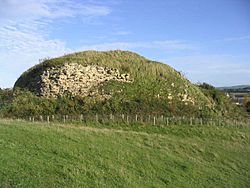Wark on Tweed Castle facts for kids
Quick facts for kids Wark on Tweed Castle |
|
|---|---|
| Northumberland, England, UK | |

The ruins of Wark on Tweed Castle
|
|
|
Location in Northumberland
|
|
| Coordinates | 55°38′30″N 2°16′55″W / 55.64162°N 2.28196°W |
Wark on Tweed Castle, sometimes called Carham Castle, is an old ruined castle. You can find it at the west end of Wark on Tweed in Northumberland, England. It started as a motte-and-bailey castle, which means it had a big mound of earth with a tower on top, and a walled courtyard below. Today, the castle ruins are a special historical site known as a Grade II* listed building.
Contents
Building Wark Castle
The castle was first built in 1136 by a person named Walter Espec. But it didn't last long! Just two years later, in 1138, Scottish forces attacked and destroyed it.
After being destroyed, the castle was rebuilt between 1157 and 1161. In the early 1200s, a strong, eight-sided tower called an octagonal keep was added to the earth mound. At the same time, new towers and a gatehouse were also built.
King Edward III and the Garter
Something famous happened at Wark Castle in 1349. King Edward III was there and helped a lady named the "Countess of Salisbury" with her garter. This moment was so important to him that he later created the Order of the Garter. This is a very old and important group of knights in England. The Countess might have been Joan of Kent or Catherine Montagu, Countess of Salisbury.
Castle Defences and Battles
Wark Castle was often involved in battles because it was close to the border between England and Scotland. It was very important for defending the area.
Improvements in the 1500s
In June 1518, Thomas Dacre described the castle after it had been fixed up. The main tower, or keep, was finished and strong enough to hold large cannons on each floor. Cannons could even be lifted up the tower using a special internal well! A watchman on top of the tower could see far away, including Norham Castle and parts of Berwick-upon-Tweed. The castle also had three courtyards, which were almost complete.
Scottish Sieges
- In November 1522, a Scottish army led by Regent Albany tried to capture Wark Castle. Sir William Lisle defended the castle bravely against French attack troops. Bad weather also helped the defenders.
- In September 1523, important English leaders, including the Earl of Surrey, visited Wark and Norham Castle. They ordered new earthwork defences for Wark. The Earl of Surrey believed the inner courtyard could hold out for 10 days, but the outer courtyard only for 2 days. He thought Wark's main tower was as strong as any he had ever seen.
Repairs and More Attacks
- In June 1524, Cardinal Wolsey ordered repairs to the keep's walls. Lead for the roof was brought from Dunstanburgh Castle.
- In March 1533, George Lawson reported that some walls near the river had fallen down.
- In September 1542, Scottish raiders attacked carts carrying stone from Carham church to the castle for repairs.
- In 1544, during a war called the Rough Wooing, the castle's captain, John Carr, complained that a part of the wall near the river had fallen.
- In February 1545, an Italian engineer named Archangelo Arcano came to help with repairs. He noticed the roofs were leaking. Lead for repairs could be brought from Kelso Abbey, which he was also helping to fortify.
- In March 1545, a list of the castle's soldiers and cannons was made. There was a cannon called a saker and a broken falcon cannon on top of the main tower.
Royal Visits and Salutes
- On April 26, 1588, King James VI of Scotland rode by on the other side of the River Tweed. The castle cannons fired a salute to him, and he sent a reward of 20 crowns.
- In 1594, the castle cannons saluted the Scottish rebel Earl of Bothwell twice. This made King James VI very angry.
The End of the Castle
Wark Castle was eventually torn down by order of King James when England and Scotland joined together in the Union of the Crowns.


